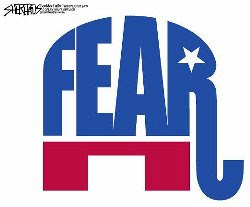Republicans have complained for years about Democrats allegedly spending too much on “big government,” but a majority of Iowans think state government is about the right size, according to the latest poll by Selzer and Co. for the Des Moines Register. The poll surveyed 805 Iowa adults between January 31 and February 3 and has a margin of error of plus or minus 3.5 percent. Respondents were asked, “In general, do you think the size of state government is too big, about right, or too small?” 52 percent said “about right” and only 39 percent said “too small.”
The Des Moines Register poll also indicates that Iowans would rather tap into the state’s tax reserves, raise fees and perhaps even raise taxes than impose massive service cuts or lay off hundreds of state workers.
The poll tested eleven options for balancing the budget and asked whether that option should be considered, strongly considered or taken off the table. The largest majority (76 percent) said consolidating some state government services should be considered or strongly considered. The Iowa legislature will pass a government reorganization bill this session, but the savings won’t be large enough to avoid other painful budget decisions.
The next largest majority (61 percent) supported considering taking up to $200 million from the state’s cash reserves. But even that probably wouldn’t be enough to balance the 2011 budget.
The other three options that at least half of respondents said should be considered were “increase fines, license fees and other user fees” (53 percent), expand gambling by allowing casinos to host large poker tournaments (51 percent) and raise the sales tax by 1 percent (51 percent).
The Register reported that several political observers found the sales tax numbers most surprising. I was more surprised to see the public evenly divided on raising the income tax. Some 48 percent of respondents said “lawmakers should consider raising state income taxes by a half percentage point; 50 percent said that idea should come off the table.”
The Register’s poll found much less support for “cutting services to thousands of Iowans” (just 33 percent favored considering that option, while 60 percent said it should be taken off the table). Only 42 percent favored considering laying off hundreds of state employees or consolidating school districts. Only 43 percent said legislators should consider eliminating all business tax credits. Just 45 percent said reducing the number of Iowa counties should be on the table.
My point is not that politicians should put blind faith in the wisdom of crowds. I don’t agree with every finding in this poll. I’d rather reduce the number of counties and scrap many business tax credits than raise the sales tax, and I find Iowans’ support for the film tax credit baffling.
The larger message from this poll is that Iowa Democrats should not cower in fear when Republicans bash “big government.” Offered a range of choices for balancing the state budget, most Iowans would prefer not to see services slashed. The Register’s November 2009 poll pointed to the same conclusion, finding broad support for spending increases Democrats have adopted in recent years.
Republicans will be cheered by the portion of Selzer’s latest poll that found one-third of Iowans called themselves supporters of the “tea party” movement, and a majority believe state government is spending too much money. To me that suggests the framing of the budget issue will be critical for this November’s elections. Democrats need to convince voters that they did all they could to find efficiencies in state government without cutting priority areas. If Republicans object, for instance, that the state could have saved tens of millions of dollars by ending the preschool initiative started in 2007, Democrats must point out that doing so would have cut off early childhood education for about 13,000 Iowa kids.

